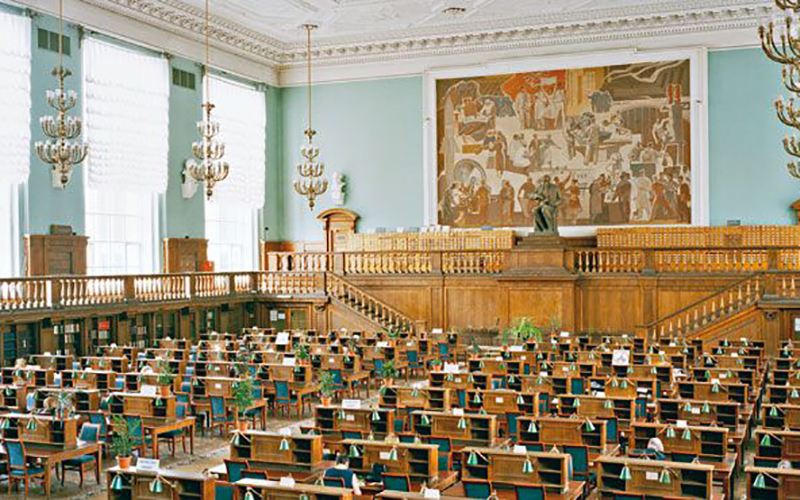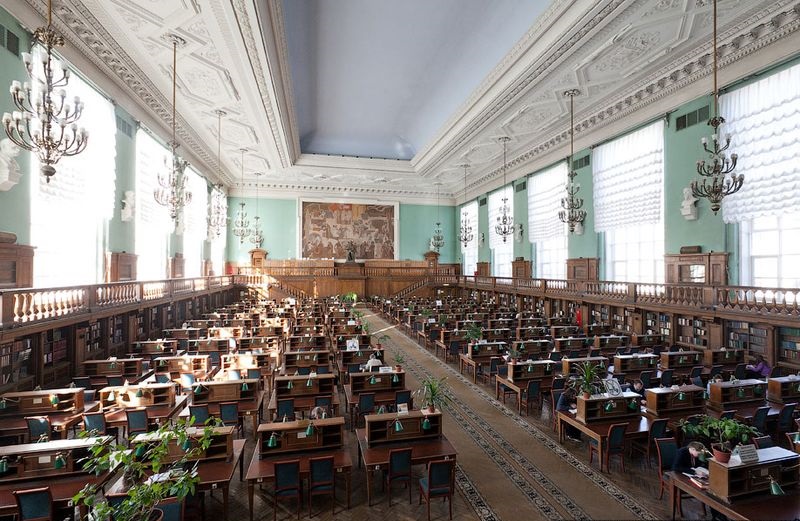Libraries in 2027

I often go to the library, and during my last visit I suddenly wondered: what could they look like 10 years later? Having rewind time to 20 years ago, when I first came to the library, I thought about that experience and decided on its basis to imagine what the libraries will be in 10 years, in 2027.
Mid nineties
I first came to the library in 1994. The catalog then served as a green text terminal, and in many books there were still paper inserts for stamping. The library was a place for quiet study and research.
')
Traditionally, libraries have provided access to information resources. Books, tapes and microfilms were the main storage devices. We could take them to the library or use them there, with the help of a librarian.
Then new media began to appear, I began to take a CD with music and games. By the middle of the zero in the libraries was already a huge selection. The model remained traditional, but with a much greater variety of information and its carriers.

Mid zero
Around this time, the Auckland libraries submitted a joint web directory, and it was a revolution.
The new catalog reflected much better the diversity of services and resources available to libraries. But much more important was the ability to order a book (or other media) online and get it in your nearest library.
I started to use them even more, ordering something (book, CD, DVD) every week. New media appeared, for example, e-books, and old ones — such as audio tapes — went into oblivion.
Due to the spread of the Internet, electronic media became obsolete by the end of this decade, and free Wi-Fi appeared in libraries.
In addition, libraries began to offer more services. For example, today in libraries there are a lot of events. Appeared self-service. In general, the model remained traditional, but expanded with the advent of new technologies and services.
2017
I believe that a modern library should have:
- Private premises and staff (librarians)
- Large collection of books and other media
- Online catalog
- Free Wi-Fi, the ability to copy, print and scan documents
- Libraries should also conduct educational and social activities for children and adults.
- More workshops began to appear in libraries in which people could gather to share ideas and work on their DIY projects.
During a trip to Melbourne, I had free time, which I decided to spend in a couple of local libraries. There I managed to try two new services.
First, you could take an iPad. With the advent of free Wi-Fi, the Internet has become one of the sources of information that you can freely use in the library, so it is not surprising that there are modern devices for accessing information.
Secondly, there was a game zone with video games (PlayStation) and board games. Excellent opportunity to have fun alone or with other people. I really liked both services, and I am sure that in the future they will appear in all libraries.
Libraries also provide many other services, such as access to local history archives or research assistance. But from the point of view of regular visitors, all this diversity turns into a basic set of services: those that I expect from a modern library.

2027
Given this basic level, let's move on for 10 years to the future and ask ourselves: will the offline libraries remain in the form of brick and concrete buildings in 2027?
I think yes. Libraries remained relevant for two decades, accompanied by fundamental technological change. They will continue to evolve, responding to new requests and using new technologies.
According to my observations, I can say that the changes will not be sudden and explosive. Libraries have always developed gradually, they have no need / opportunity for a radical change of course. On the contrary, it will be an evolutionary movement, with a slow paradigm shift.
To understand the value of libraries for me personally, I asked three questions.
- Why have I used libraries in the past?
- Why will I use them in the future?
- How has their customer value changed?
As part of the traditional model of providing access to information resources, libraries were a place where it was possible to do research, turn to primary sources and gain knowledge.
There is the so-called DIKW pyramid (data, information, knowledge, wisdom - data, information, knowledge, wisdom) - this is an information hierarchy, where each level adds certain properties to the previous level. That is, in order to obtain information, you need data, and in order to gain knowledge, you need information, and so on.

Originally, libraries were the source of the first three levels of the pyramid. But since the beginning of the new millennium, the two lower levels — data and information — have gone online. Now we get there all the data and information.
It seems to me that the main value of the library lies precisely in the field of knowledge. From a place to study, it has become a place to study.
How is “learning” different from “learning”? I think so:
- Teach - search for information, read, memorize facts, go to school and so on in order to get information about the subject
- To study - to gain knowledge or skills while studying, practicing, adopting them from someone or acquiring them in the process of practical exercises.
Spaces that allow people to learn something while interacting are becoming more accessible. A good example is workshops and related training activities.
In addition, due to the trend towards self-service, many tasks that previously required the help of a librarian are automated: such as searching for books, using a printer, exchanging coins.
The paradox is that the library has ceased to be an intermediary between a person and information, but has retained the spirit of mediation, transferring it into interaction with people. It becomes a place for learning and communication, becomes a means to achieve this goal.
If we present these changes as a diagram, I think that by 2027 the libraries will be located somewhere in the middle of the blue arrow.

In 2027, libraries will offer a similar basic set of services, of course, responding to the development of technologies: wireless printers, an upgraded delivery service, and reception centers in the form of micro-libraries and kiosks.
By 2027, artificial intelligence, Google and Amazon bots will become so smart that the answer to any of our questions will be just a click away. Or maybe it will be immediately downloaded to our heads with the help of a variety of sensors and notifications.
As the old value of libraries — access to information — disappears, modification becomes the main competitive strategy.
Libraries must change. They have to offer what their huge and well-designed online competitors cannot offer. To do this, they need to use their key asset — premises — and win, giving people more opportunities to learn and socialize.
It will be necessary to stop being just an information warehouse, becoming instead a place for people to interact with each other. In addition, the interaction is not limited to talking, you can use books, toys, games, musical instruments, electronics.
I think that in the library of 2027 there will be fewer carriers that you can take home. Most of the information will be found in the online catalog, and only selected copies will be displayed in the libraries, which will allow them to free up space.
These instances, such as popular literary novelties, may be chosen by the librarian or, more likely, by the mining algorithm. Everything else can be stored elsewhere and brought on request.
There will be a section of specialized services, such as research and archives. A few traditional workstations or tables will remain, but most of the space will be a free zone for various activities.
Visitors will be able to use the space as they want - to play games, watch videos over Wi-Fi, solder electronics or even practice playing drums in a soundproof fence. Someone can conduct group training. A budding pianist could play a piano standing in a corner - that's your live music. Moreover, the library may have open-air space for outdoor activities. In short, the library will be a platform for social interaction.
By 2027, the premises occupied by libraries will become more valuable and more attractive than their collections.
Already today libraries allow not only to use their collections, but also to interact with the community. I see that these changes will continue, and in the future we will be able to use for our purposes book collections, each other, the entire community and, of course, the library premises.
Libraries can be fully integrated into public space - imagine a library at the airport or train station. And they can partly - for example, when there is a main building and several kiosks in crowded places, so that customers have a convenient way to return books.
Architecture is another growth area for libraries. In ancient cities, they usually occupy objects of architectural heritage. And new libraries are being built in a modern style, using the latest approaches, such as green heating, water reuse, and so on.
When my library opened, its business card was eco-design, which was completely new to public places fifteen years ago. And libraries located in historic buildings can become significant landmarks for the city. They can even attract tourists. New or restored libraries have a great opportunity to become examples of modern, advanced architecture.
Historical - or vice versa, the modern, futuristic library space can in itself become its value proposition.
"It is very difficult to make an accurate forecast, especially about the future," - Niels Bohr.
This is just one of the versions of the possible development of events. The reality, of course, will be different for each city and country, and will depend on the service model chosen by the library, the characteristics of the local community and the views of local authorities.
At last
The future of libraries in many ways comes down to space and time. Libraries will become a place for activities that combine leisure and learning. Libraries will increase their own value, providing opportunities for interaction and spending free time with benefits.
Regardless of what the future will be to stay afloat in 2027, the leadership of a successfully developing library must think strategically, anticipate the future and provide good service. These time-tested rules will never change.

Source: https://habr.com/ru/post/341452/
All Articles